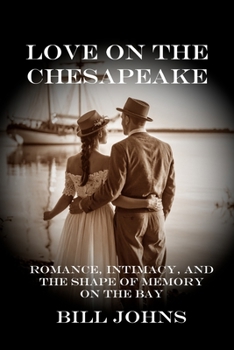Love on the Chesapeake: Romance, Intimacy, and the Shape of Memory on the Bay
Love, romance, and the slow rhythms of intimacy find a unique expression on the Chesapeake Bay. In a world shaped by tides, storms, and shoreline gatherings, Love on the Chesapeake: Romance, Intimacy, and the Shape of Memory on the Bay is a deeply evocative cultural history that captures how love has been practiced, concealed, endured, and remembered along the largest estuary in North America. From oyster roasts and crab feasts to porch lights left burning for boats delayed by fog, the Chesapeake Bay has always offered a setting where intimacy is shaped by weather, labor, and place. This book traces the hidden architecture of affection-from 19th-century skipjack courtships and ferry-bound proposals to the quiet endurance of elder love and the unspoken bonds between working couples. Here, intimacy does not announce itself. It docks slowly, tends nets, keeps silence in storm, and returns by habit rather than spectacle. Drawing on diaries, letters, oral histories, and the author's own memories of a life spent boating its waters since the 1950s, this work presents a layered and textured portrait of love's many forms: romantic, filial, queer, interracial, and platonic. It tells of island couples who measured time in tides, not calendars; of love letters written between oyster hauls or slipped inside hymnals; of mixed-race partnerships that found shelter in the crevices of segregated shores; and of a widow's ritual walk along the same dock her husband once paced waiting for the mailboat. The Bay does not separate love from labor. It binds them. A man gutting bluefish beside his wife, silent and precise, is showing more than skill. He is showing fidelity.
In communities where water often came between what the world put together, the Chesapeake forged a culture in which affection endured not in grand declarations, but in acts of return. A lantern placed in a window. A tackle box never opened but still kept aboard. A skiff renamed but still moored in the same slip, year after year. These are not artifacts of sentimentality. They are expressions of an emotional vernacular native to shoreline life. Unlike the metropolitan cultures that favor performance and immediacy, the estuarial world offers a slower intimacy. Love here is not a climax but a cadence. It is not tested by words but by weather. And its deepest rituals-crab boils held each August, oyster roasts remembered more by the steam than the faces-become liturgies of belonging. Even absence carries weight: a crab net left unmended, a hymn hummed alone, a name spoken to no one in particular but still carried on the tide. Through eighteen chapters and a resonant coda, Love on the Chesapeake explores the Bay's emotional topography with precision, compassion, and reverence for what the shoreline remembers. These stories are not nostalgia. They are cartographies of memory-maps drawn in mud and light, in tide tables and touch. They remind us that on the Chesapeake, love never leaves cleanly. It recedes, reshapes, and then, if we are quiet enough, returns. For readers drawn to literary nonfiction, regional history, and deeply human stories of devotion shaped by place, this book offers not just a portrait of a region, but a reflection of what it means to love in rhythm with the natural world. Whether you know the Bay or have never stepped aboard a deadrise, this is a book for anyone who has waited by a window, who has kept a light on for someone returning, or who understands that the truest forms of affection are not announced, but practiced-again and again. Come listen to the Bay's lessons. Its tide still speaks. What it teaches is not how to love once, but how to keep loving across distance, silence, and time.
In communities where water often came between what the world put together, the Chesapeake forged a culture in which affection endured not in grand declarations, but in acts of return. A lantern placed in a window. A tackle box never opened but still kept aboard. A skiff renamed but still moored in the same slip, year after year. These are not artifacts of sentimentality. They are expressions of an emotional vernacular native to shoreline life. Unlike the metropolitan cultures that favor performance and immediacy, the estuarial world offers a slower intimacy. Love here is not a climax but a cadence. It is not tested by words but by weather. And its deepest rituals-crab boils held each August, oyster roasts remembered more by the steam than the faces-become liturgies of belonging. Even absence carries weight: a crab net left unmended, a hymn hummed alone, a name spoken to no one in particular but still carried on the tide. Through eighteen chapters and a resonant coda, Love on the Chesapeake explores the Bay's emotional topography with precision, compassion, and reverence for what the shoreline remembers. These stories are not nostalgia. They are cartographies of memory-maps drawn in mud and light, in tide tables and touch. They remind us that on the Chesapeake, love never leaves cleanly. It recedes, reshapes, and then, if we are quiet enough, returns. For readers drawn to literary nonfiction, regional history, and deeply human stories of devotion shaped by place, this book offers not just a portrait of a region, but a reflection of what it means to love in rhythm with the natural world. Whether you know the Bay or have never stepped aboard a deadrise, this is a book for anyone who has waited by a window, who has kept a light on for someone returning, or who understands that the truest forms of affection are not announced, but practiced-again and again. Come listen to the Bay's lessons. Its tide still speaks. What it teaches is not how to love once, but how to keep loving across distance, silence, and time.
Format:Paperback
Language:English
ISBN:B0FD8PJSQG
ISBN13:9798288104466
Release Date:June 2025
Publisher:Independently Published
Length:398 Pages
Weight:1.17 lbs.
Dimensions:0.8" x 6.0" x 9.0"
Customer Reviews
0 rating





